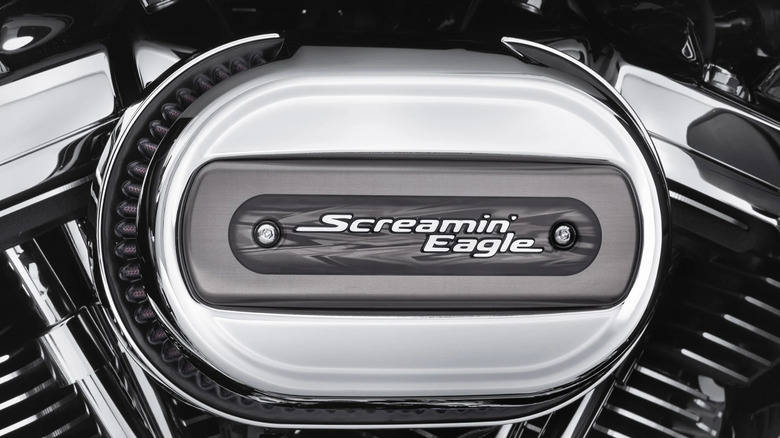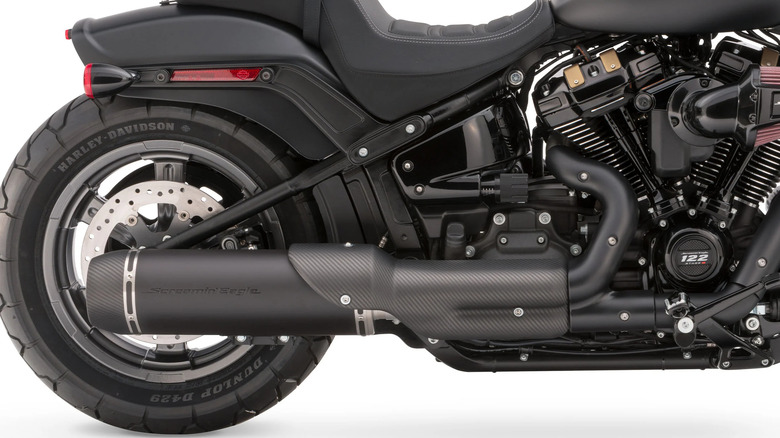What Is A Harley-Davidson Stage 1 Upgrade And How Much Does It Cost?
Harley-Davidson motorcycles, generally speaking, are high-performance vehicles meant to really showcase their automotive musculature. Harley-Davidson has one of the most renowned pedigrees of motorcycle manufacturers, so it would naturally behoove it to output only the very best in quality. As with any other vehicle, however, the exact definition of "performance" can vary depending on the wants and needs of the rider.
For example, let's say you purchased a simpler, more affordable Harley-Davidson bike like an Iron 883 or a Street 500. Those aren't bad bikes by any means, but compared to something a little more powerful and speedy like a Road Glide ST, they're obviously going to fall short.
If you want to bring your humble Harley a little more in line with the big boys, the brand actually offers a multistage upgrading process to really kick things into high gear. As with a higher-end Harley, this process isn't exactly cheap, with prices on the first stage alone ranging from $500 to $1,500 or more. For that cost, though, you get a total overhaul on your engine's ability to draw in and process oxygen, improving its overall performance.
A Stage 1 upgrade is focused on improving air circulation in your Harley's engine
Each stage in Harley-Davidson's upgrading process focuses on a different aspect of the bike's performance and functionality. For the first stage, the name of the game is oxygen. Your motorcycle may not be a living thing, but it needs air as much as you or me in order to ignite fuel and power the engine. Improving air circulation in your Harley bike allows the engine to take in more oxygen, which in turn improves the rate at which fuel is utilized and allows your engine to do its best work.
The Stage 1 upgrade is actually made up of several sub-steps, with the first step upgrading the air intake and filter. Manufacturers can only use air systems that allow a certain level of air into the engine per industry regulations, but upgrades are aftermarket, so you can bend the rules a bit.
After the air intake system has been upgraded, the second step is upgrading the exhaust. Not only does this help to further improve the air circulation in your engine, but also allows you to fine-tune that classic Harley-Davidson engine roar.
The final step is re-tuning the engine to properly utilize the upgraded parts. You can keep your existing tuning system if you want, but you can also have a new tuner installed specifically to cater to the new parts' needs.
Put all of this together, and you get improved engine airflow, more responsive throttle and acceleration, and a small, yet notable increase in horsepower and torque.
The cost can range from $500 to $1,500 or more depending on the parts used
Sadly, nothing in life is free. The prospect of a Stage 1 upgrade may seem attractive if you want more performance out of your Harley, but the cost of upgrading can be a bit steep. It may not be as much as buying an entirely new bike, but it's an investment, so you'd better make sure you really like that bike and want to keep driving and caring for it.
The precise cost of a Stage 1 upgrade varies a bit depending on the exact parts you utilize in the upgrading process. The first step alone, replacing the air intake and filter, can run you anywhere from $200 to $600. Harley-Davidson has a variety of different parts available, so you can choose which one you want if you need something with specific features or a lower price tag.
In addition to the intake, you'll also need to pay the price for a new exhaust. The precise parts available will vary depending on where you get the work done, but expect to pay around $600 at the bare minimum. Finally, there's the new tuning system, which can run you another $450 for Harley-Davidson's latest model.
You might be able to save some cash by using lower-tier parts, and for those well-versed in motorcycle work, riders have attested to handling the installation themselves to cut costs. All in all, though, you should expect to pay anywhere from $500 to $1,500 in total, possibly more.


